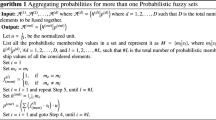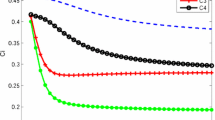Abstract
The probabilistic dual hesitant fuzzy set (PDHFS), as an extension of generalization of the dual hesitant fuzzy set, contains not only the hesitation values of membership degree (MD) and non-membership degree (NMD), but also considers the probabilities corresponding to MDs and NMDs, which are the degree of support and confidence of the decision makers in the evaluation value given by them. Distance measures, entropy measures, and cross-entropy measures are important tools in multi-attribute decision-making. In the PDHFS environment, distance and entropy measures are improved, and cross-entropy is proposed, and multi-attribute decision-making methods based on distance and entropy and cross-entropy are given. First, in order to effectively compare the distances between different PDHFSs, we improve the existing distance measures. Second, we review the existing formulations of probabilistic dual hesitant fuzzy entropy and find that they could not effectively distinguish the uncertainty of different PDHFSs due to ignoring the uncertainty caused by the differences between different MDs and between different NMDs, so we improve the existing entropy measure. Additionally, the formulas and properties of the cross-entropy of PDHFS and the axiomatic definition of the generalized cross-entropy of PDHFS are given. Finally, depending on the distance and entropy and cross-entropy built, we propose a new multi-attribute decision method to solve the multi-attribute decision problem with completely unknown attribute weights. We apply the proposed method to the protective decision-making for the release of radioactive substances, and the feasibility of the method is verified by comparative analysis.
Similar content being viewed by others
Data availability
Not applicable.
References
Ali Z, Mahmood T, Ullah K (2021) Picture hesitant fuzzy clustering based on generalized picture hesitant fuzzy distance measures. Knowledge 1(1):40–51
Biplab S, Mausumi S, Nidul S (2019) Modified distance measure on hesitant fuzzy sets and its application in multi-criteria decision-making problem. Opsearch 57(2):584–602
Boffa S, Ciucci D (2023) Logical entropy and aggregation of fuzzy orthopartitions. Fuzzy Sets and Syst 455:77–101
Chen SJ, Chen SM (2001) A new method to measure the similarity between fuzzy numbers. In: 10th IEEE International Conference on Fuzzy Systems..
Chen SM, Phuong BDH (2017) Fuzzy time series forecasting based on optimal partitions of intervals and optimal weighting vectors. Knowled-Based Syst. https://doi.org/10.1016/j.knosys.2016.11.019
Chen SM, Wang CH (2009) Fuzzy risk analysis based on ranking fuzzy numbers using alpha-cuts, belief features and signal/noise ratios. Expert Syst Appl. https://doi.org/10.1016/j.eswa.2008.06.112
Dhankhar C, Kumar K (2022) Multi-attribute decision-making based on the advanced possibility degree measure of intuitionistic fuzzy numbers. Granular Comput 8(3):467–478
Dong JY, Wan SP, Chen SM (2021) Fuzzy best-worst method based on triangular fuzzy numbers for multi-criteria decision-making. Informat Sci 547(1):1080–1104
Du YW, Zhong JJ (2023) Dynamic multicriteria group decision-making method with automatic reliability and weight calculation. Informat Sci 634:400–422
Erdal H, Kurtay KG, Dagistanli HA, Altundas A (2023) Evaluation of anti-tank guided missiles: an integrated fuzzy entropy and fuzzy CoCoSo multi criteria methodology using technical and simulation data. Appl Soft Comp J 137:110145
Gao XZ, Pan LP, Deng Y (2021) Cross entropy of mass function and its application in similarity measure. Applied Intelligence, 2021.
Garg H, Kaur G (2018) Algorithm for probabilistic dual hesitant fuzzy multi-criteria decision-making based on aggregation operators with new distance measures. Mathematics 6(12):280
Hao ZN, Xu ZS, Zhao H, Su Z (2017) Probabilistic dual hesitant fuzzy set and its application in risk evaluation. Knowled-Based Syst 127:16–28
Harish G, Gagandeep K (2019) A robust correlation coefficient for probabilistic dual hesitant fuzzy sets and its applications. Neural Comp Appl 32(13):8847–8866
Jun Y (2016) Cross-entropy of dual hesitant fuzzy sets for multiple attribute decision-making. Int J Decis Supp Syst Technol (IJDSST) 8(3):20–30
Khalaj M, Tavakkoli MR, Khalaj F, Siadat A (2020) New definition of the cross entropy based on the Dempster-Shafer theory and its application in a decision-making process. Communicat Statist—Theory Methods 49(4):909–923
Kumar D, Kumari A (2022) Reliability appraisal of a system using interval-valued probabilistic dual hesitant fuzzy element. Mater Today 57(P5):1995–2001
Li ZY, Zhang XY, Wang WJ, Li Z (2022) Multi-criteria probabilistic dual hesitant fuzzy group decision making for supply chain finance credit risk assessments. Expert Syst. https://doi.org/10.1111/exsy.13015
Liu PD, Cheng SF (2019) Interval-valued probabilistic dual hesitant fuzzy sets for multi-criteria group decision-making. Int J Comput Intell Syst 12(2):1393
Ning BQ, Lei F, Wei GW (2022a) CODAS method for multi-attribute decision-making based on some novel distance and entropy measures under probabilistic dual hesitant fuzzy sets. Int J Fuzzy Syst 24(8):3626–3649
Ning BQ, Wei GW, Guo YF (2022b) Some novel distance and similarity measures for probabilistic dual hesitant fuzzy sets and their applications to MAGDM. Int J Mach Learn Cybern 13(12):3887–3907
Ning BQ, Wei GW, Lin R, Guo YF (2022c) A novel MADM technique based on extended power generalized Maclaurin symmetric mean operators under probabilistic dual hesitant fuzzy setting and its application to sustainable suppliers selection. Expert Syst Appl 204:117419
Noor Q, Rashid T, Beg I (2022) Multi-attribute group decision-making based on probabilistic dual hesitant fuzzy Maclaurin symmetric mean operators. Granular Comput 8(3):633–666
Ren ZL, Xu ZS, Wang H (2019) The strategy selection problem on artificial intelligence with an integrated VIKOR and AHP method under probabilistic dual hesitant fuzzy information. IEEE Access. https://doi.org/10.1109/ACCESS.2019.2931405
Rogulj K, Kilić PJ, Ivić M (2021) Hybrid MCDM based on VIKOR and cross entropy under rough neutrosophic set theory. Mathematics 9(12):1334
Shahzaib A, Saleem A, Muneeza, (2020) Some novel aggregation operators for cubic picture fuzzy information: application in multi-attribute decision support problem. Granular Comput 6:603–618
Shao ST, Zhang XH (2021) Multiobjective programming approaches to obtain the priority vectors under uncertain probabilistic dual hesitant fuzzy preference environment. Int J Comput Intell Syst 14(1):1189
She LL, Han SL, Liu XW (2021) Application of quantum-like Bayesian network and belief entropy for interference effect in multi-attribute decision making problem. Comp Industrial Eng 157:107307
Song J, Ni ZW, Jin FF, Li P, Wu WY (2021a) A new group decision making approach based on incomplete probabilistic dual hesitant fuzzy preference relations. Comp Intell Syst 7(6):3033–3049
Song J, Ni ZW, Jin FF, Wu WY, Li P (2021b) Consensus-based group decision-making methods with probabilistic dual hesitant fuzzy preference relations and their applications. J Intell Fuzzy Syst 41(1):2111–2128
Su BJ, Lu FY, Zhu F (2022) A probabilistic dual hesitant fuzzy multi-attribute decision making method based on entropy and correlation coefficient. Operat Res Manag 31(02):23–28 ((in Chinese))
Tiantian B, Xie XL, Long PY, Wei ZK (2017) MADM method based on prospect theory and evidential reasoning approach with unknown attribute weights under intuitionistic fuzzy environment. Expert Syst Appl 88:305–317
Torra V (2010) Hesitant fuzzy sets. Int J Intell Syst 25(6):529–539
Wang PP, Chen JH (2023) A large group emergency decision making method considering scenarios and unknown attribute weights. Symmetry 15(1):223
Xu ZS, Zhou W (2017) Consensus building with a group of decision makers under the hesitant probabilistic fuzzy environment. Fuzzy Optim Decis Making 16(4):481–503
Yan F, Zhou XQ, Wang YZ, Chen L, Li W (2022) Novel distance measure for hesitant fuzzy sets and its application to K-Means clustering. International Journal of Fuzzy System Applications (IJFSA) 11(1):1–32
Zadeh LA (1965) Fuzzy sets. Inf. Control 8:338–353
Zarandi A (2010) On fuzzy information theory. Ind J Sci Technol 3(9):1020–1025
Zeb A, Khan A, Fayaz M, Izhar M (2022) Aggregation operators of Pythagorean fuzzy bi-polar soft sets with application in multiple attribute decision making. Granular Comput. https://doi.org/10.1007/s41066-021-00307-w
Zeeshan M, Khan M, Anis S, Iqbal S (2022) Novel distance measures based on complex fuzzy sets with applications in signals. Comput Appl Mathemat. https://doi.org/10.1007/s40314-022-02002-1
Zeng WY, Ma R, Liu ZP, Xi Y, Yin Q, Xu ZS (2022) Some novel distance measures between dual hesitant fuzzy sets and their application in medical diagnosis. Int J Intell Syst. https://doi.org/10.1002/int.22960
Zeng W (2011) Inclusion measure of interval-valued fuzzy sets. ICIC Express Letters, 5(8 A).
Zhang H (2020) Distance and entropy measures for dual hesitant fuzzy sets. Comput Appl Mathem. https://doi.org/10.1007/s40314-020-1111-2
Zhang YM, Jia XY, Tang ZM (2021) Information-theoretic measures of uncertainty for interval-set decision tables. Information Sciences,577.
Zhao Q, Ju Y, Pedrycz W (2020) A method based on bivariate almost stochastic dominance for multiple criteria group decision making with probabilistic dual hesitant fuzzy information. IEEE Access 8:203769–203786
Zhu B, Xu Z, Xia M (2012) Dual hesitant fuzzy sets. J Appl Math 2012:2607–2645
Author information
Authors and Affiliations
Contributions
Wang Pingping: conceptualization, writing—original draft preparation, methodology, supervision; Chen Jiahua: writing—review and editing, validation. All authors have read and agreed to the published version of the manuscript.
Corresponding author
Ethics declarations
Conflict of interest
The authors declare no conflict of interest.
Institutional review board statement
Not applicable.
Informed consent
Not applicable.
Additional information
Publisher’s Note
Springer Nature remains neutral with regard to jurisdictional claims in published maps and institutional affiliations.
Rights and permissions
Springer Nature or its licensor (e.g. a society or other partner) holds exclusive rights to this article under a publishing agreement with the author(s) or other rightsholder(s); author self-archiving of the accepted manuscript version of this article is solely governed by the terms of such publishing agreement and applicable law.
About this article
Cite this article
Wang, P., Chen, J. A probabilistic dual hesitant fuzzy multi-attribute decision-making method based on entropy and cross-entropy. Granul. Comput. 8, 1739–1750 (2023). https://doi.org/10.1007/s41066-023-00397-8
Received:
Accepted:
Published:
Issue Date:
DOI: https://doi.org/10.1007/s41066-023-00397-8




